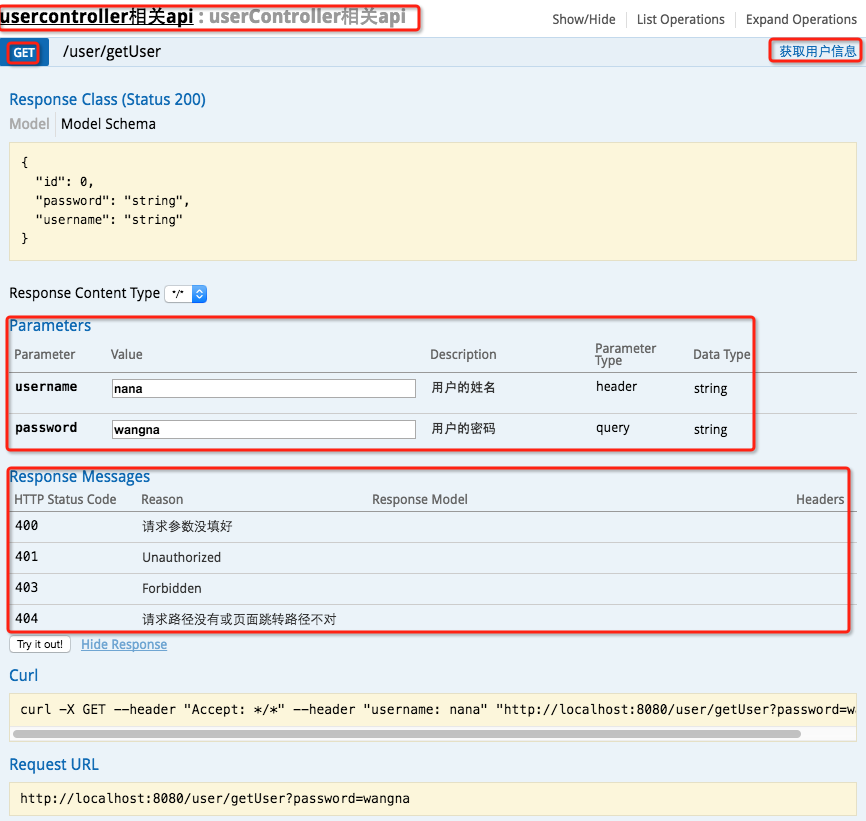第四章 springboot + swagger(转载)
此篇博客转发自:http://www.cnblogs.com/java-zhao/p/5348113.html
swagger用于定义API文档。
好处:
- 前后端分离开发
- API文档非常明确
- 测试的时候不需要再使用URL输入浏览器的方式来访问Controller
- 传统的输入URL的测试方式对于post请求的传参比较麻烦(当然,可以使用postman这样的浏览器插件)
- spring-boot与swagger的集成简单的一逼
1、项目结构
和上一节一样,没有改变。
2、pom.xml
引入了两个jar。
<dependency>
<groupId>io.springfox</groupId>
<artifactId>springfox-swagger2</artifactId>
<version>2.2.2</version>
</dependency>
<dependency>
<groupId>io.springfox</groupId>
<artifactId>springfox-swagger-ui</artifactId>
<version>2.2.2</version>
</dependency>
3、Application.java
package com.xxx.firstboot; import org.springframework.boot.SpringApplication;
import org.springframework.boot.autoconfigure.SpringBootApplication; import springfox.documentation.swagger2.annotations.EnableSwagger2; @SpringBootApplication //same as @Configuration+@EnableAutoConfiguration+@ComponentScan
@EnableSwagger2 //启动swagger注解
public class Application { public static void main(String[] args) {
SpringApplication.run(Application.class, args);
} }
说明:
- 引入了一个注解@EnableSwagger2来启动swagger注解。(启动该注解使得用在controller中的swagger注解生效,覆盖的范围由@ComponentScan的配置来指定,这里默认指定为根路径"com.xxx.firstboot"下的所有controller)
4、UserController.java
package com.xxx.firstboot.web; import org.springframework.beans.factory.annotation.Autowired;
import org.springframework.web.bind.annotation.RequestHeader;
import org.springframework.web.bind.annotation.RequestMapping;
import org.springframework.web.bind.annotation.RequestMethod;
import org.springframework.web.bind.annotation.RequestParam;
import org.springframework.web.bind.annotation.RestController; import com.xxx.firstboot.domain.User;
import com.xxx.firstboot.service.UserService; import io.swagger.annotations.Api;
import io.swagger.annotations.ApiImplicitParam;
import io.swagger.annotations.ApiImplicitParams;
import io.swagger.annotations.ApiOperation;
import io.swagger.annotations.ApiResponse;
import io.swagger.annotations.ApiResponses; @RestController
@RequestMapping("/user")
@Api("userController相关api")
public class UserController { @Autowired
private UserService userService; // @Autowired
// private MyRedisTemplate myRedisTemplate; @ApiOperation("获取用户信息")
@ApiImplicitParams({
@ApiImplicitParam(paramType="header",name="username",dataType="String",required=true,value="用户的姓名",defaultValue="zhaojigang"),
@ApiImplicitParam(paramType="query",name="password",dataType="String",required=true,value="用户的密码",defaultValue="wangna")
})
@ApiResponses({
@ApiResponse(code=400,message="请求参数没填好"),
@ApiResponse(code=404,message="请求路径没有或页面跳转路径不对")
})
@RequestMapping(value="/getUser",method=RequestMethod.GET)
public User getUser(@RequestHeader("username") String username, @RequestParam("password") String password) {
return userService.getUser(username,password);
} // @RequestMapping("/testJedisCluster")
// public User testJedisCluster(@RequestParam("username") String username){
// String value = myRedisTemplate.get(MyConstants.USER_FORWARD_CACHE_PREFIX, username);
// if(StringUtils.isBlank(value)){
// myRedisTemplate.set(MyConstants.USER_FORWARD_CACHE_PREFIX, username, JSON.toJSONString(getUser()));
// return null;
// }
// return JSON.parseObject(value, User.class);
// } }
说明:
- @Api:用在类上,说明该类的作用
- @ApiOperation:用在方法上,说明方法的作用
- @ApiImplicitParams:用在方法上包含一组参数说明
- @ApiImplicitParam:用在@ApiImplicitParams注解中,指定一个请求参数的各个方面
- paramType:参数放在哪个地方
- header-->请求参数的获取:@RequestHeader
- query-->请求参数的获取:@RequestParam
- path(用于restful接口)-->请求参数的获取:@PathVariable
- body(不常用)
- form(不常用)
- name:参数名
- dataType:参数类型
- required:参数是否必须传
- value:参数的意思
- defaultValue:参数的默认值
- paramType:参数放在哪个地方
- @ApiResponses:用于表示一组响应
- @ApiResponse:用在@ApiResponses中,一般用于表达一个错误的响应信息
- code:数字,例如400
- message:信息,例如"请求参数没填好"
- response:抛出异常的类
- @ApiModel:描述一个Model的信息(这种一般用在post创建的时候,使用@RequestBody这样的场景,请求参数无法使用@ApiImplicitParam注解进行描述的时候)
- @ApiModelProperty:描述一个model的属性
以上这些就是最常用的几个注解了。
需要注意的是:
- ApiImplicitParam这个注解不只是注解,还会影响运行期的程序,例子如下:

如果ApiImplicitParam中的phone的paramType是query的话,是无法注入到rest路径中的,而且如果是path的话,是不需要配置ApiImplicitParam的,即使配置了,其中的value="手机号"也不会在swagger-ui展示出来。
具体其他的注解,查看:
https://github.com/swagger-api/swagger-core/wiki/Annotations#apimodel
测试:
启动服务,浏览器输入"http://localhost:8080/swagger-ui.html"

最上边一个红框:@Api
GET红框:method=RequestMethod.GET
右边红框:@ApiOperation
parameter红框:@ApiImplicitParams系列注解
response messages红框:@ApiResponses系列注解
输入参数后,点击"try it out!",查看响应内容:

第四章 springboot + swagger(转载)的更多相关文章
- 第四章 springboot + swagger
http://www.cnblogs.com/java-zhao/p/5348113.html
- 第五章 springboot + mybatis(转载)
本编博客转发自:http://www.cnblogs.com/java-zhao/p/5350021.html springboot集成了springJDBC与JPA,但是没有集成mybatis,所以 ...
- 第七章 springboot + retrofit(转载)
本篇博客转发自:http://www.cnblogs.com/java-zhao/p/5350861.html retrofit:一套RESTful架构的Android(Java)客户端实现. 好处: ...
- 第六章 springboot + 事务(转载)
本篇博客转发自:http://www.cnblogs.com/java-zhao/p/5350106.html 在实际开发中,其实很少会用到事务,一般情况下事务用的比较多的是在金钱计算方面. myba ...
- 第三章 springboot + jedisCluster(转载)
本编博客转发自:http://www.cnblogs.com/java-zhao/p/5347703.html 如果使用的是redis2.x,在项目中使用客户端分片(Shard)机制. 如果使用的是r ...
- 第二十四章 springboot注入servlet
问:有了springMVC,为什么还要用servlet?有了servlet3的注解,为什么还要使用ServletRegistrationBean注入的方式? 使用场景:在有些场景下,比如我们要使用hy ...
- 第十四章 springboot + profile(不同环境读取不同配置)
具体做法: 不同环境的配置设置一个配置文件,例如:dev环境下的配置配置在application-dev.properties中:prod环境下的配置配置在application-prod.prope ...
- 第二十五章 springboot + hystrixdashboard
注意: hystrix基本使用:第十九章 springboot + hystrix(1) hystrix计数原理:附6 hystrix metrics and monitor 一.hystrixdas ...
- [Effective Java]第四章 类和接口
声明:原创作品,转载时请注明文章来自SAP师太技术博客( 博/客/园www.cnblogs.com):www.cnblogs.com/jiangzhengjun,并以超链接形式标明文章原始出处,否则将 ...
随机推荐
- [C#基础知识] ReadOnly关键字修饰的变量可以修改,只是不能重新分配
转自:http://www.cnblogs.com/sujiantao/archive/2011/12/19/2289357.html MSDN 官方的解释 readonly 关键字是可以在字段上使用 ...
- Oracle死锁处理
SELECT s.username,l.OBJECT_ID,l.SESSION_ID,s.SERIAL#, l.ORACLE_USERNAME,l.OS_USER_NAME,l.PROCESS,b.O ...
- python中的浅拷贝和深拷贝
1.赋值语句 a = 'abc' b = a print id(a) print id(b) # id(a):29283464 # id(b):29283464 通过简单的复制,我们可以看到,a b其 ...
- .NET (一)委托第一讲:什么是委托
1.为什么要使用委托? 生活中的委托就是委托他人帮我们去办一件事情,程序中的委托类似.看下面的例子 class Class1 { static void Main(String[] args) { L ...
- js实现继承的两种方式
这是面试时面试官会经常问到问题: js的继承方式大致可分为两种:对象冒充和原型方式: 一.先说对象冒充,又可分为3种:临时属性方式.call().apply(): 1.临时属性方式: 当构造对象son ...
- Docker学习过程中遇到的问题及解决方法
1.重新安装Docker后,运行不起来 [root@zyt-test-14-53 ~]# docker infoCannot connect to the Docker daemon. Is the ...
- FFT的分析以及matlab实验
FFT(Fast Fourier Transformation),即为快速傅氏变换,是离散傅氏变换(DFT)的快速算法. 采样得到的数字信号,做FFT变换,N个采样点,经过FFT之后,就可以得到N个点 ...
- javascript知识点总结----Function定义
---恢复内容开始--- 函数Function: 函数实际上是对象,每个函数都是Function类型的实例,而且都与其他引用类型一样具有属性和方法,函数名实际上是一个指向函数的指针,不会与某个函数绑定 ...
- Linux 之加密类型,CA,Openssl,Openssh
TCP/IP:安全 A------->B 机密性:明文传输(ftp,http,smtp,telnet),被窃听 完整性:消息被篡改 身份验证:你访问的主机就是你真实要访问的那台,而不是钓鱼网站 ...
- HTTP权威协议笔记-7.集成点:网关、隧道及中继
.8.1 网关 定义:网关类似与翻译器,它抽象出了一种能够到达资源的方法. 实用:网关可以自动将HTTP流量转换为其他协议,这样使用HTTP协议的一方就不需要了解其他协议,也可实现与其他程序或设备交互 ...
